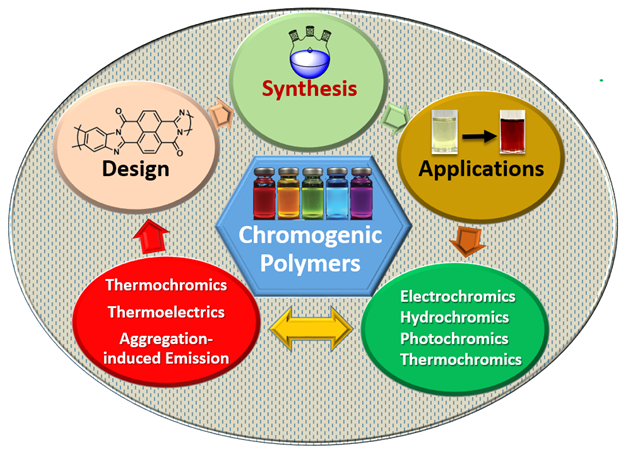Chromogenic Polymers
In general, chromogenic polymers are defined as polymers that can change their color and transparency in response to light, electricity, temperature, mechanical force or pH variations. In other words, an external stimulus such as light, voltage, heat, etc., will trigger a partial or entire transformation of polymer chemical structures and hence lead to alterations in physical and chemical properties of polymers. The chromogenic polymers are categorized as electrochromic, photochromic, thermochromic, hydrochromic, ionochromic, mechanochromic, etc.
These polymers show unique stimuli-responsive traits and are expected to have a wide spectrum of applications in many areas. For example, electrochromic polymers that exhibit change in color upon oxidation and/or reduction due to application of external electrical potential bias have been found very useful in smart windows, smart glasses, mirrors as well as military camouflage paint. Chromogenic
Polymers group is interested to design and synthesize a variety of chromogenic polymers, most recently, focusing on the development of electrochromic, hydrochromic polymers. In addition, as an extension of chromogenic conjugated polymers, this group is also very keen on studying thermoelectrics and aggregation-induced emission polymers for low-grade thermal energy harvesting and chemosensors, respectively.
Capabilities
These polymers show unique stimuli-responsive traits and are expected to have a wide spectrum of applications in many areas. For example, electrochromic polymers that exhibit change in color upon oxidation and/or reduction due to application of external electrical potential bias have been found very useful in smart windows, smart glasses, mirrors as well as military camouflage paint. Chromogenic
Polymers group is interested to design and synthesize a variety of chromogenic polymers, most recently, focusing on the development of electrochromic, hydrochromic polymers. In addition, as an extension of chromogenic conjugated polymers, this group is also very keen on studying thermoelectrics and aggregation-induced emission polymers for low-grade thermal energy harvesting and chemosensors, respectively.
Capabilities
- Design and synthesis of a range of π-conjugated molecules and polymers using various advanced organic synthesis methods
- Electrochromic conjugated polymers and electrochromic devices
- Hydrochromic molecules and polymers
- Thermoelectric polymers and thermoelectric devices
- Aggregation-induced emission (AIE)-active molecules and AIE-active polymers
Highlights and Achievements
- Y Zheng, et al, Chem. Soc. Rev. 2021, accepted. “Defect engineering in thermoelectric materials: what have we learned?”.
- ZM Png, et al, Org. Lett. 2020, 22 (13), 5009-5013. “Carboxylic acid directed C–H arylation of azulene”
- T Tang, et al, Chem. Commun. 2020, 56 (65), 9388-9391. “Water-dispersible conducting polyazulene and its application in thermoelectrics”
- TLD Tam, et al, J. Mater. Chem. A 2020, 8 (36), 18916-18924. “The benzyl viologen radical cation: an effective n-dopant for poly (naphthalenediimide-bithiophene)”
- H Zhou, et al, ACS Appl. Energy Mater. 2020, 3 (7), 6726-6734. “Photoresponsive thermoelectric materials derived from fullerene-C60 PEDOT hybrid polymers”
- H Zhou, et al, Polym. Chem. 2019, 10 (28), 3822-3840. “Aggregation-induced emission (AIE)-active polymers for explosive detection”
- MH Chua, et al, Solar Energy Mater. Solar Cells 2019, 197, 32-75. “Diversity of electron acceptor groups in donor–acceptor type electrochromic conjugated polymers”
- H Zhou, et al., ACS Appl. Nano Mater. 2018, 2 (1), 470-478. “Ionofluorochromic nanoparticles derived from octapyrene-modified polyhedral oligomeric silsesquioxane organic frameworks for fluoride-ion detection”
- WT Neo, et al, Mater. Chem. Front. 2018, 2 (2), 331-337. “Influence of catalytic systems in Stille polymerization on the electrochromic performance of diketopyrrolopyrrole-based conjugated polymers”
- MH Chua, et al J. Mater. Chem. C 2017, 5 (46), 12194-12203. “Triphenylethylenyl-based donor–acceptor–donor molecules: studies on structural and optical properties and AIE properties for cyanide detection”
- Editor of RSC Book: Electrochromic Smart Materials: Fabrication and Applications (Smart Materials Series (Volume 33)), 1st Edition (2019)
- Editor of Elsevier Book: Aggregation-Induced Emission (AIE) --- A Practical Guide (2022)
Contact
A*STAR celebrates International Women's Day

From groundbreaking discoveries to cutting-edge research, our researchers are empowering the next generation of female science, technology, engineering and mathematics (STEM) leaders.
Get inspired by our #WomeninSTEM
.png?sfvrsn=b59474e9_3)
